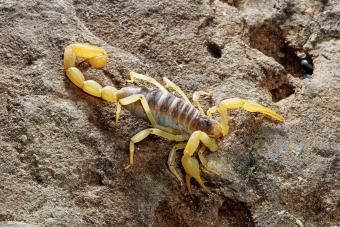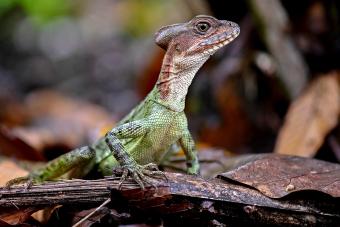
Pet scorpions just have a "cool" factor. There's nothing like telling your friends your new pet has a stinger. Even though they don't move around a lot and aren't super-interactive, they're still fun to watch and take care of. They're also low-maintenance, making them ideal for busy people.
Minimal Input Pets
While they might not be the first choice for certain owners, scorpions can make interesting and low-maintenance additions to the homes of exotic pet enthusiasts. They don't require a lot of space, time, or investment to be kept successfully.
However, this could come with an argument from those who live in places scorpions are native. After all, scorpions do have venom and can sting, and you need to be aware that these are not pets for handling. There are about 90 species of scorpion in the United States. Most of them live in Arizona. But they also enjoy the hot climates of California and New Mexico.
Types, Appearance, and Size
There are more than 1,500 scorpion species worldwide, but only a few are suitable for life in captivity. Some popular scorpion species for beginners include:
Emperor Scorpion

The emperor scorpion (Pandinus imperator) is the scorpion that's recommended for beginners. This species is docile, and the venom is more likely to pinch you than sting you. Plus, they don't generally become aggressive unless they feel threatened.
These guys weigh about an ounce and range from 6 to 8 inches. They have a large black body with broad pinschers. Most of the time you'll see them in black, but you could find them in dark blue.
Desert Hairy Scorpion

The desert scorpion (Hadrurus arizonensis) species are relatively docile, but their sting will get you. Their venom is more potent than the emperor scorpion, and comes with a punch. The bite is quite painful. They're also quite skittish and more likely to sting than the emperor.
The desert hairy scorpion ranges from 5 to 6 inches. They weigh about the same as the emperor scorpion; about 1 ounce. Their coloration ranges from tan to olive green, with yellow claws, tail, and legs. They also have brown hairs on their tail.
Tanzanian Red-Clawed Scorpion

The Tanzanian red-clawed scorpion (Pandinus cavimanus) is in the same genus as the emperor scorpion, but it's smaller than most other scorpions. They are also more aggressive than others, but their sting feels more like a bee sting. Less painful than the desert hairy scorpion, but more painful than the emperor.
They're between 4 to 5 inches in length, weighing the same as most others around an ounce. They have a black body. They also have a rusty red coloring on their claws.
Malaysian Black Scorpion

The Malaysian black scorpion (Heterometrus spinifer) is found in the rainforest and is more difficult to locate for purchase than the emperor scorpion. They're also more aggressive, but like the emperor, they're more prone to pinching than stinging. They have mild venom that generally only causes the area to be painful and swollen.
They weigh about 1 ounce. Their length ranges from 4 to 5 inches, so they're a tiny bit smaller than some other species. They have large claws and a shiny black body.
If you see scorpions for sale in the genus Androctonus, stay away! Androctonus means 'man killer,' and that's not an exaggeration.
Lifespan
Scorpions are slow to mature, taking between 1 to 4 years to become fully mature. Most live between 3 to 5 years. However, the emperor scorpion (P. imperator) lives longer than most at about 8 years.
Handling Your Scorpion
Handling scorpions is generally discouraged, as it can cause unnecessary stress for the animal and carry the risk of stings or pinches. Scorpions are best appreciated from a safe distance and should generally not be handled unless absolutely necessary. If handling is necessary, use long tweezers or tongs to gently move your scorpion.
If you need to remove your scorpion from its enclosure, you can coat it into a small, plastic container with a ventilated lid. Use your tongs to gently nudge it into the temporary enclosure.
Care Requirements

Caring for a pet scorpion involves providing a secure and species-appropriate enclosure, maintaining proper temperature and humidity levels, offering a balanced diet, and ensuring a safe and stress-free environment.
Enclosure Size and Setup
A 5 to 10-gallon glass or plastic terrarium with a secure, well-ventilated lid is an ideal enclosure for most pet scorpions. Ensure that the enclosure is escape-proof, as scorpions are skilled climbers and can easily scale the walls of their habitat.
The size of the enclosure can vary depending on the species and the number of scorpions housed together. Some smaller species may do well in a smaller enclosure, while larger species may require more space.
Substrate
Choose a substrate that replicates the scorpion's natural environment. Desert species require a 4- to 6-inch layer of sand or a sand-and-coconut coir mix, while tropical species thrive on moisture-retaining substrates like coconut coir or peat moss. Ensure the substrate is deep enough for your scorpion to burrow if it is a burrowing species.
Temperature and Humidity
Scorpions require specific temperature and humidity levels to thrive. Desert species need a temperature range of 75 to 85 degrees Fahrenheit, and a humidity level between 40 and 50%.
Tropical species require slightly higher temperatures, between 80 and 90 degrees Fahrenheit, and humidity levels of 70 to 80%. Use heat mats, ceramic heat emitters, or heat lamps to maintain the appropriate temperature, and a hygrometer to monitor humidity levels. Misting once or twice daily and monitoring the humidity should be enough to maintain the appropriate levels.
Lighting
Photoperiod lighting is necessary for 8 to 12 hours, but don't leave it on throughout the night. Scorpions need infrared or nocturnal light during the night hours. You can often see their hue at night with this type of lighting.
Hides
Scorpions are nocturnal and need hiding spots to feel secure during the day. Provide multiple hide options for your scorpion. Include hiding spots, such as cork bark, half-logs, or clay flower pots, to replicate their natural environment.
Scorpions stay in their hide without food for a few days before they molt. Don't panic if you notice them in there a few days at a time on occasion.
Diet and Feeding

Scorpions are carnivorous and primarily feed on insects such as crickets, mealworms, or roaches. Feed your scorpion live prey one to two times per week. Adjust the quantity and frequency depending on your scorpion's size, species, and life stage.
Live crickets can harm your pet scorpion if not removed immediately after they're done feeding.
Water
Provide a shallow water dish for your scorpion to drink from. Ensure the dish is not too deep to prevent drowning. Mist the enclosure lightly to maintain appropriate humidity levels, but avoid over-misting, as this can lead to mold growth.
Health Concerns
Scorpions are relatively healthy, but they can be prone to the following:
- Dehydration: Dehydration is a common issue that can occur if a scorpion's habitat lacks sufficient humidity or access to a water source. Symptoms include lethargy, weight loss, and a wrinkled or shrunken appearance. To prevent dehydration, provide a shallow water dish and maintain appropriate humidity levels.
- Mites: Mites are tiny parasites that can infest your scorpion's enclosure, feeding on the scorpion's blood and causing stress, irritation, and poor health.
- Infections: Scorpions can develop infections from injuries, such as cuts or punctures, often caused by fights with tank mates or unsuitable enclosure items.
- Molting problems: Molting is a natural process where scorpions shed their exoskeleton to grow. However, complications can arise, such as incomplete molts or a scorpion becoming stuck in its old exoskeleton.
Finding a Pet Scorpion
Finding the perfect pet scorpion requires careful research and consideration. Begin by familiarizing yourself with different scorpion species, focusing on their temperament, care requirements, and suitability as pets. Determine if the scorpion species you're looking into is what you truly want.
Before acquiring a pet scorpion, ensure that keeping this species is legal in your area. Some regions have restrictions on owning exotic pets or require permits.
Availability
The emperor scorpion is the species that you will often find at your local pet specialty store, especially if they focus on reptiles. Other scorpions are harder to find. But they can be found with breeders and at reptile expos. Avoid purchasing wild-caught specimens, as this contributes to the decline of wild populations and may cause a less healthy or more stressed pet.
Always check the legal restrictions on keeping scorpions in your area and obtain any necessary permits before acquiring one.
Cost
You should expect to pay between $15 and $50 for a pet scorpion. You might need to pay more for certain species. Also, reputable breeders may charge more than the local pet store, but you can expect a healthier pet from a specialized breeder.
FAQs About Pet Scorpions
The following are commonly asked questions about pet scorpions:
- Do scorpions know how to swim? No, scorpions don't swim. But they can move out of the water if they find themselves in their water dish.
- How many legs do scorpions have? Scorpions have two pinschers and six legs (8 limbs total, not including their tails).
- Is the scorpion a type of bug? No, scorpions aren't bugs. They're considered predatory arachnids.
- How many eyes do scorpions have? Scorpions have six to 12 eyes with two larger eyes at the center of their carapace, with smaller eyes on each side of their body.
- Can any scorpions be held? Scorpions, in general, should not be handled. Although some may tolerate being handled better than others, it still puts unnecessary stress on them - and greatly increases your chance of being stung.
Is a Pet Scorpion Right for You?
Pet scorpions can be a good pet for the right person. But if you're looking for a pet to hold, this is definitely not the one. They're not the cute, cuddly kind. They're the type you watch and admire from afar.







